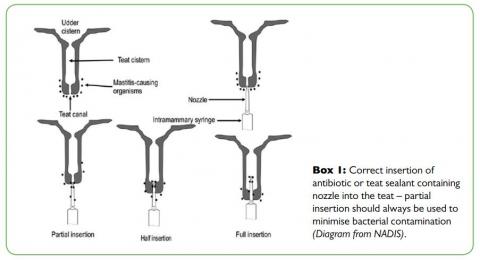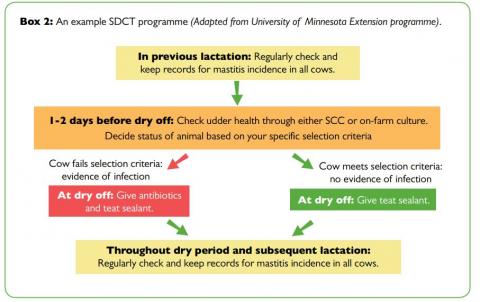Dr Ruth Wonfor: IBERS, Aberystwyth University
Take home messages:
- Blanket dry cow therapy should be considered an unacceptable practice. This is in line with the Wales Animal Health and Welfare Framework’s recommendation of ‘promoting the minimising of routine use of antibiotics’.
- Selective dry cow therapy is straightforward to implement on farm and will reduce your use of antibiotics. If you have a high incidence rate of mastitis in your herd, veterinary advice should be sought.
- Teat sealants are a useful tool to reduce the likelihood of quarters which are healthy at dry off becoming infected in the dry period and consequently should reduce your mastitis rate in the next lactation without having to use antibiotics.
The dry period is crucial in the lactation process. It is the period after lactation that allows for the repair of the udder lining and subsequent optimal milk production in the next lactation. Within the repair process, milk secretion dries up, the udder lining gets smaller and reduces activity and a keratin plug forms in the teat canal.
The dry period is not just utilised for repair of the udder but also to clear up any mammary infections. Previous cases of clinical or subclinical mastitis can be treated and new infections prevented. Prevention of new infections from environmental bacteria in the dry period is imperative as these can become clinical cases after calving. It may seem odd that there is still a risk from bacteria getting into the teat whilst there is a keratin plug present. However, the formation of the keratin plug may be delayed, and cows are more susceptible to infection in the initial period after drying off. Furthermore, in high yielding dairy cattle, milk leakage can occur meaning that the teat is not effectively sealed, these animals are reported to be four times more likely to get an infection.
Blanket dry cow therapy (BDCT) has been a standard method for both treatment and prevention in the dry period. This method uses antibiotics in all quarters of all cows in the herd at drying off. During the dry period, higher doses can be used than when the cow is in milk and the flow of milk at milking will not flush the antibiotic out. However, by blanket treating the herd with antibiotic dry cow therapy there will be many cows in the herd that are treated with antibiotics when they don’t need it. This is considered prophylactic use of antibiotics and as a practice should be discouraged. Antimicrobial resistance is a real problem in human and veterinary medicine and we are running out of options. Therefore, the whole of the agricultural sector needs to do its best to reduce the use of antibiotics as much as possible, without impacting animal health and welfare. Furthermore, minimising the routine use of antibiotics is a key component of the Wales Animal Health and Welfare Framework. The industry needs to start planning what will be done in place of BDCT and at present selective dry cow therapy (SDCT) and use of teat sealants is considered a sensible alternative. An added financial incentive should also be realised by reduced expenditure on unnecessary antibiotic treatments.
What is selective dry cow therapy?
SDCT is the treatment of cows with antibiotics based on an assessment of the presence of an intra-mammary infection before drying off – usually determined through somatic cell counts. This method can either be administered at the cow or quarter level, though it is likely more easily implemented at the cow level in practice.
What should be done about the cows that don’t receive antibiotics and how do we prevent any new infections during the dry period?
Teat sealants with or without antibiotics are becoming more common in dry cow management, with internal sealants being favoured over external sealants. Internal sealants are infused into the teat canal and act as a barrier to any invading environmental bacteria. The sealant is a paste which will stay intact in the teat in the presence of milk and is stripped out at the first suckling or stripping out post calving. When somatic cell counts are low before dry off and there is no history of mastitis in the previous lactation there has been shown to be no benefit to using antibiotic treatment over teat sealants alone. Further to this, there are a number of research studies which have shown that the use of teat sealants in the dry period reduces the prevalence of mastitis in the subsequent lactation. One study reported up to 48% reduction, compared to cows that receive no treatment. Based on this evidence, it seems likely that using teat sealants within a selective dry cow therapy programme will be easily implemented into common practice in dairy farming in the future, with no anticipated negative effects on animal health or welfare.
When inserting either teat sealants or intra-mammary antibiotics, care must always be taken to follow manufacturers’ guidelines and to minimise the risk of introduction of environmental bacteria into the teat. Clean gloves should always be worn, the teat properly cleaned and hygiene kept to the highest standard. This is even more important when using teat sealants without concurrent antibiotic treatment. If not completed properly, the risk of an intramammary infection is increased. The nozzle containing either the antibiotic or teat sealant should only be partially inserted into the teat as demonstrated in Box 1.
How can I implement SDCT on my farm?
Before implementation you and your vet will need to decide on strict selection criteria. As previously mentioned, the most common selection tool used is SCC. The current advised cut off is 200,000 cells/ mL. This should be discussed with your vet who may recommend an alternative based on your individual herd parameters and history. Any cows that have SCC equal to or over this level should receive antibiotic treatment and a teat sealant and those with less and no history of clinical mastitis should only receive teat sealants. Use of SCC as a selection method and the consideration of incidents of clinical mastitis in the previous lactation will give a fairly good accuracy for selecting uninfected cows to receive teat sealants alone, although this could be improved on through other methods.
Recent research in Canada and the USA has evaluated on-farm culture system to detect the presence of bacteria in the milk. Although these systems would require a clean ‘lab’ space on the farm or your vet to culture samples, they do give results quickly and are also more accurate for detecting cows that require SDCT than the SCC selection tools. It is likely that methods such as this will be developed further in the future and become more common on-farm.
Box 2 outlines a suggested example of a SDCT programme that could be instigated on-farm. Selection criteria for the programme would depend on the method chosen to detect the presence of infection at dry off. Each programme will need to be farm specific to meet your individual requirements and could be instigated at whole cow or quarter level, although whole cow level has previously been recommended. Advice should be sought from your vet or a suitably qualified person on how to set up and implement this programme.
What should I do if I have a high percentage of cows with SCC >200,000 cells/mL?
On farms with a high prevalence of mastitis and where many cows have SCC greater than 200,000 cells/ mL at dry off, the majority may still need antibiotics and so, there will be limited room to reduce antibiotic use at this time. On these farms the overall herd management should be looked at first and any areas for improvement targeted to reduce the mastitis prevalence. Practices such as improvement of housing and udder cleanliness milking hygiene and milking equipment being in good repair may be a useful place to start. Disease management should always involve discussions with your vet. Once the cases of mastitis in the herd are reduced, use of antibiotics within the dry period should be required less and a SDCT regime could be implemented.
SDCT in practice: Farming Connect work at Tyreglwys Demonstration Farm
Work at one of our Demonstration Farms Tyreglwys has been investigating the use of SDCT and teat sealants alongside the farm’s vet. A strict cell count cut off of less than 120,000 in 3 monthly recordings before dry off and no history of mastitis in that period was used as a selection method for teat sealants alone. This selection criterion identified 80% of the herd to be eligible for teat sealants alone. The antibiotic usage for the dry period was reduced and a saving of £7.40 per cow was made. More information on this project is available here.


